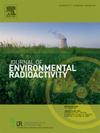Prediction of anthropogenic 129I in the South China Sea based on machine learning
IF 2.1
3区 环境科学与生态学
Q3 ENVIRONMENTAL SCIENCES
引用次数: 0
Abstract
With the rapid increase in the number of nuclear power plants along the China coast and the potential for releases of radioactive substances to marine ecosystems, it is important to investigate and predict the dispersion of radionuclides in the seas and assess their radiological risks. Due to iodine's high solubility in water, and the high fission yield and long half life of 129I, it has been widely used for investigation of anthropogenic radioactive pollution dispersion in the marine environment. This work established a method to predict the dispersion of anthropogenic 129I in the seas by machine learning. Two models: 1) a Random Forest model, and 2) a Support Vector Machine model, which were developed using measured 129I and 127I values from seawater in the northwestern South China Sea. Spearman analysis was employed to investigate the influence of various environmental parameters on 129I levels, with water depth, temperature, and salinity identified as the main parameters affecting 129I levels. The sensitivity of machine learning model outputs to different environmental parameters was determined; with salinity being the most significant parameter. Both models demonstrated good prediction performance as seen in comparisons of predicted data with measurement values (R2 > 0.83). Based on a comprehensive evaluation of model metrics, the Random Forest model slightly outperformed the Support Vector Machine model. The model can be easily applied to predict the dispersion of soluble anthropogenic radionuclide in marginal seas, providing an effectively technical support for radiological risk assessment and emergency responses of nuclear pollution and accidents.
基于机器学习的南海人为129I预测
随着中国沿海核电站数量的迅速增加和放射性物质对海洋生态系统的潜在释放,对放射性核素在海洋中的扩散进行调查和预测并评估其辐射风险具有重要意义。由于碘在水中的高溶解度,以及129I的高裂变产率和长半衰期,它已被广泛用于海洋环境中人为放射性污染扩散的研究。本工作建立了一种通过机器学习预测海洋中人为129I扩散的方法。利用南海西北部海域129I和127I的实测数据,建立了随机森林模型和支持向量机模型。采用Spearman分析法研究各环境参数对129I水平的影响,确定水深、温度和盐度是影响129I水平的主要参数。确定了机器学习模型输出对不同环境参数的敏感性;盐度是最重要的参数。从预测数据与测量值的比较中可以看出,两个模型都表现出良好的预测性能(R2 >;0.83)。基于对模型指标的综合评估,随机森林模型略优于支持向量机模型。该模型可方便地用于预测可溶性人为放射性核素在边缘海域的扩散,为核污染和事故的辐射风险评估和应急响应提供有效的技术支持。
本文章由计算机程序翻译,如有差异,请以英文原文为准。
求助全文
约1分钟内获得全文
求助全文
来源期刊

Journal of environmental radioactivity
环境科学-环境科学
CiteScore
4.70
自引率
13.00%
发文量
209
审稿时长
73 days
期刊介绍:
The Journal of Environmental Radioactivity provides a coherent international forum for publication of original research or review papers on any aspect of the occurrence of radioactivity in natural systems.
Relevant subject areas range from applications of environmental radionuclides as mechanistic or timescale tracers of natural processes to assessments of the radioecological or radiological effects of ambient radioactivity. Papers deal with naturally occurring nuclides or with those created and released by man through nuclear weapons manufacture and testing, energy production, fuel-cycle technology, etc. Reports on radioactivity in the oceans, sediments, rivers, lakes, groundwaters, soils, atmosphere and all divisions of the biosphere are welcomed, but these should not simply be of a monitoring nature unless the data are particularly innovative.
 求助内容:
求助内容: 应助结果提醒方式:
应助结果提醒方式:


